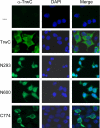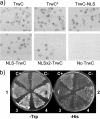Nuclear targeting of a bacterial integrase that mediates site-specific recombination between bacterial and human target sequences
- PMID: 21037296
- PMCID: PMC3019720
- DOI: 10.1128/AEM.01371-10
Nuclear targeting of a bacterial integrase that mediates site-specific recombination between bacterial and human target sequences
Abstract
TrwC is a bacterial protein involved in conjugative transfer of plasmid R388. It is transferred together with the DNA strand into the recipient bacterial cell, where it can integrate the conjugatively transferred DNA strand into its target sequence present in the recipient cell. Considering that bacterial conjugation can occur between bacteria and eukaryotic cells, this protein has great biotechnological potential as a site-specific integrase. We have searched for possible TrwC target sequences in the human genome. Recombination assays showed that TrwC efficiently catalyzes recombination between its natural target sequence and a discrete number of sequences, located in noncoding sites of the human genome, which resemble this target. We have determined the cellular localization of TrwC and derivatives in human cells by immunofluorescence and also by an indirect yeast-based assay to detect both nuclear import and export signals. The results indicate that the recombinase domain of TrwC (N600) has nuclear localization, but full-length TrwC locates in the cytoplasm, apparently due to the presence of a nuclear export signal in its C-terminal domain. The recombinase domain of TrwC can be transported to recipient cells by conjugation in the presence of the helicase domain of TrwC, but with very low efficiency. We mutagenized the trwC gene and selected for mutants with nuclear localization. We obtained one such mutant with a point A904T mutation and an extra peptide at its C terminus, which maintained its functionality in conjugation and recombination. This TrwC mutant could be useful for future TrwC-mediated site-specific integration assays in mammalian cells.
Figures






Similar articles
-
Site-specific integration of foreign DNA into minimal bacterial and human target sequences mediated by a conjugative relaxase.PLoS One. 2012;7(1):e31047. doi: 10.1371/journal.pone.0031047. Epub 2012 Jan 23. PLoS One. 2012. PMID: 22292089 Free PMC article.
-
The Conjugative Relaxase TrwC Promotes Integration of Foreign DNA in the Human Genome.Appl Environ Microbiol. 2017 May 31;83(12):e00207-17. doi: 10.1128/AEM.00207-17. Print 2017 Jun 15. Appl Environ Microbiol. 2017. PMID: 28411218 Free PMC article.
-
Site-specific recombinase and integrase activities of a conjugative relaxase in recipient cells.Proc Natl Acad Sci U S A. 2005 Nov 8;102(45):16385-90. doi: 10.1073/pnas.0506081102. Epub 2005 Oct 31. Proc Natl Acad Sci U S A. 2005. PMID: 16260740 Free PMC article.
-
Conjugative transposition.Annu Rev Microbiol. 1995;49:367-97. doi: 10.1146/annurev.mi.49.100195.002055. Annu Rev Microbiol. 1995. PMID: 8561465 Review.
-
Structure and function of the shufflon in plasmid R64.Adv Biophys. 2004;38:183-213. Adv Biophys. 2004. PMID: 15493334 Review.
Cited by
-
Exchange of functional domains between a bacterial conjugative relaxase and the integrase of the human adeno-associated virus.PLoS One. 2018 Jul 17;13(7):e0200841. doi: 10.1371/journal.pone.0200841. eCollection 2018. PLoS One. 2018. PMID: 30016371 Free PMC article.
-
Site-specific integration of foreign DNA into minimal bacterial and human target sequences mediated by a conjugative relaxase.PLoS One. 2012;7(1):e31047. doi: 10.1371/journal.pone.0031047. Epub 2012 Jan 23. PLoS One. 2012. PMID: 22292089 Free PMC article.
-
The Conjugative Relaxase TrwC Promotes Integration of Foreign DNA in the Human Genome.Appl Environ Microbiol. 2017 May 31;83(12):e00207-17. doi: 10.1128/AEM.00207-17. Print 2017 Jun 15. Appl Environ Microbiol. 2017. PMID: 28411218 Free PMC article.
-
Transfer of R388 derivatives by a pathogenesis-associated type IV secretion system into both bacteria and human cells.J Bacteriol. 2011 Nov;193(22):6257-65. doi: 10.1128/JB.05905-11. Epub 2011 Sep 9. J Bacteriol. 2011. PMID: 21908662 Free PMC article.
-
Design of Novel Relaxase Substrates Based on Rolling Circle Replicases for Bioconjugation to DNA Nanostructures.PLoS One. 2016 Mar 30;11(3):e0152666. doi: 10.1371/journal.pone.0152666. eCollection 2016. PLoS One. 2016. PMID: 27027740 Free PMC article.
References
-
- Bartolomé, B., Y. Jubete, E. Martínez, and F. de la Cruz. 1991. Construction and properties of a family of pACYC184-derived cloning vectors compatible with pBR322 and its derivatives. Gene 102:75-78. - PubMed
-
- Buchanan-Wollaston, V., J. E. Passiatore, and F. Cannon. 1987. The mob and oriT mobilization functions of a bacterial plasmid promote its transfer to plants. Nature 328:172-175.
-
- Cambronne, E. D., and C. R. Roy. 2006. Recognition and delivery of effector proteins into eukaryotic cells by bacterial secretion systems. Traffic 7:929-939. - PubMed

